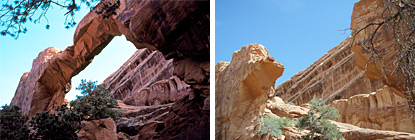
Barry & Steve's "Rock On" Cream @ Twin Rocks Trading Post
To access the southwestern part of Utah from our home town, one must either head north and angle south, or start south and strike north; there is no direct route. Leaving late in the afternoon, I chose the southerly course, and was west of Page, Arizona as the sun began to fade.
Beginning to feel a little lonely as shadows spread across the red rock undulations near Lake Powell, I switched on the FM radio and searched for a station. There was nothing but empty air and scratchy signals. Now, I am no stranger to vacuous spaces and static; at the Twin Rocks we have plenty of both. On this particular occasion, however, I was craving something more.
Just outside Kanab, the search hit on a classic rock station, and I eased back in the seat and set the cruise control. These were the songs of my youth, and I was in the company of friends. As the radio played Me & Bobby McGee and Satisfaction, I began considering how rock had become the central theme of my life. Not the musical variety, however, it is rocks from the Bisbee, Royston, Morenci, Number 8, Carico Lake, Blue Gem and a variety of other turquoise mines that threaten to overwhelm me.
That, I have come to understand, is not at all unusual. Turquoise, as it turns out, is a magical, mystical stone; something a child of the ‘60s and ‘70s should have instinctively understood. The metaphysical and psychedelic aspects of that era had, however, passed me by without so much as a whisper, so I was slow to comprehend.
The story of turquoise reaches back over 6,000 years, and the archaeological record places the stone in Egypt’s First Dynasty; five centuries before the Christian era. Although I have long maintained that Barry is so addicted to turquoise he would inject it if possible, I was recently surprised to find that the mineral has historically been ground into a fine powder and consumed as a cure for many ailments. This remedy is said to mitigate nervousness, relieve stress and promote harmony.
At the trading post, we have turquoise made into beads, carved into fetishes, inlaid into bracelets, set into pottery and cut into every imaginable geometric shape. To my knowledge, however, we had never considered ingesting it.
Thinking my new realization may comprise a significant business opportunity, I mentioned it to Barry. You can imagine his excitement. After all those years of being consumed by turquoise, Barry finally believed he might actually devour it. This appeared to be a watershed moment, and a new direction for the trading post.
First, however, I cautioned him we must do our due diligence and develop a sound business plan. Scientists and pharmacists would have to be contacted, ministers consulted, bankers convinced and investors secured. As I carefully proceeded through this tedious process, I began to notice a cabochon missing here and an empty bezel there. Barry denied any knowledge of these incidents.
All of the sudden, however, Barry began speaking of harmony, world peace and free love. I became seriously concerned when he arrived at work wearing beads, a flowery shirt and flip flops, but there was no direct evidence. Finally one morning I noticed a blue film around his mouth and, pushing him aside, quickly searched his desk. There in the back corner of the drawer, under the baseball trading cards, was what I was looking for; a vial of turquoise powder and a bag of partially ground cabochons.
After a little independent research, we have struck a deal to blend Barry’s turquoise powder with Nellie Tsosie’s Miracle Cream. Clinical trials for the topical cream are proceeding, and the results are encouraging. We expect FDA approval within the next twelve months, and an initial public offering is planned. Our motto will be “Rock On”.
Peace, love and turquoise to all.
Steve, Barry and the Team.
Copyright 2008 Twin Rocks Trading Post






